GIVE ME LIGHT
On board the new CL Yachts flagship that is full of surprises
As unconventional as it comes on the outside, the new CLX96 by CL Yachts is an engineering marvel that’s full of surprises, says Cecile Gauert
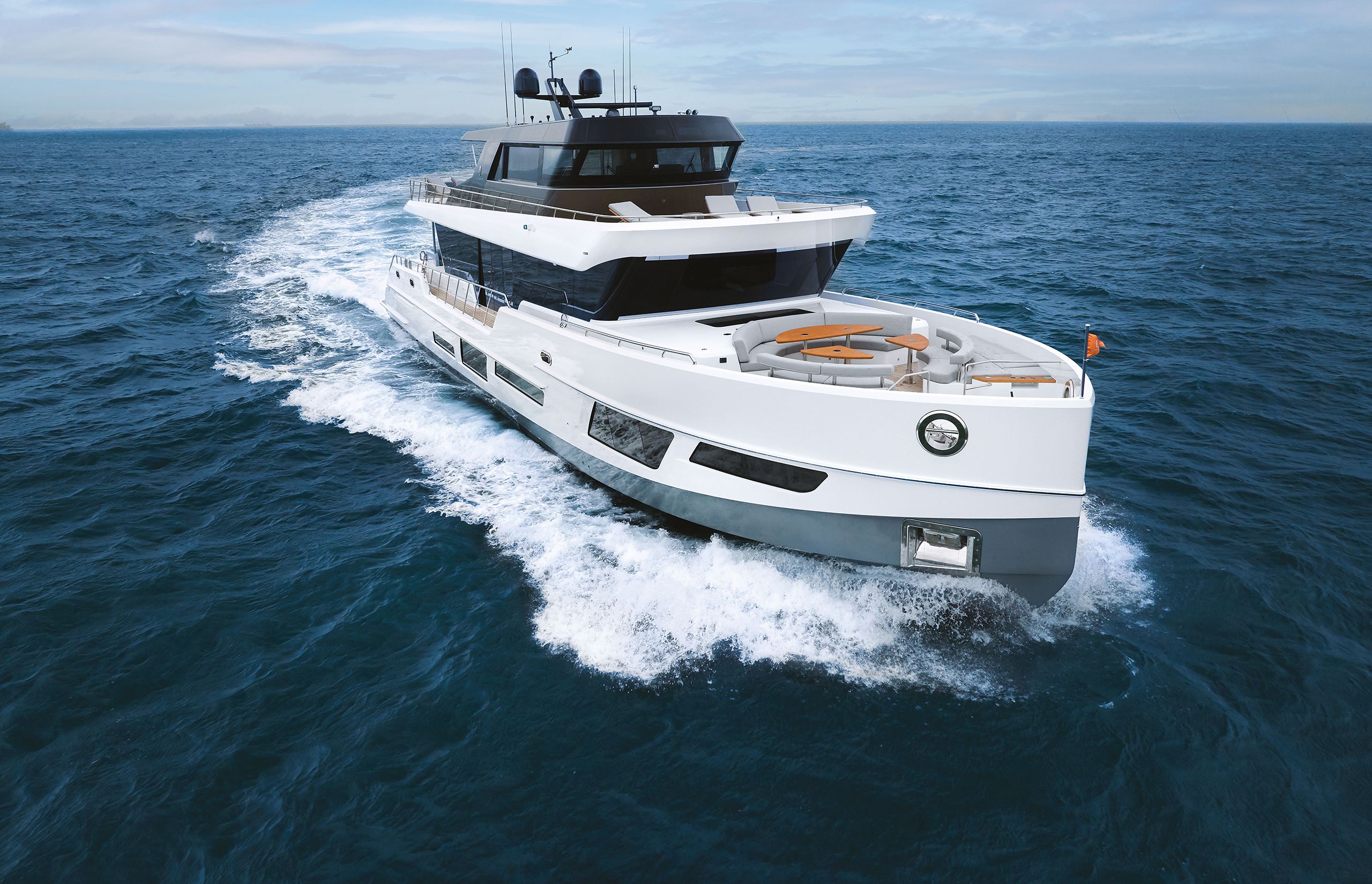
Sunshine, half-a-metre seas and an easterly wind. Lovely but not the kind of conditions likely to pose a challenge for CL Yachts’ much-anticipated CLX96. Our two hours offshore feel more like a pleasure cruise than a trial. A baby is on board, shortly lulled to sleep by the yacht’s gentle motion. Other passengers include the baby’s father and the yacht’s designer, Jozeph Forakis, naval architect Earl Alfaro, structural engineer Al Horsmon and several members of the CL Yachts team.
I’d like to leave aside the exterior design for a moment, even if this unusual exterior is what stands out – everyone has an opinion about it. Let’s look at this CLX96 from other angles first.
The visit starts from the transom and its multi-purpose platform by Z-lift, which handles up to 800 kilograms and accommodates a tender of up to 4.4 metres; a davit is hidden nearby to assist with the tender launch. From here, we move up the stairs to the main deck, where the set-up is pleasantly casual. Sofas with storage underneath easily extend to allow tall adults to fully stretch out. “Transformability and multifunctionality are a theme throughout the whole boat,” Forakis says.
“Here, we get a full wet service bar, refrigerator, freezer, sink, and a 42-inch colour TV pops down [from the ceiling],” the designer points out. A sliding hatch leads to the crew area.
We walk past the stairs to the upper deck along a comfortable side deck with secure handrails to what Forakis calls the Piazza del Sole, a convivial lounge organised in a circle. Here again, there is lots of flexibility with tables and headrests that move up and down and sofas that morph into loungers with the addition of cushions. It’s also practical, with plenty of storage. The lounge, which can be shaded, is safely separated from the work area, including the anchor pocket and windlasses.
The top deck is a convertible space with opening windows and doors, making the air-conditioned wheelhouse, which includes seating and storage, a truly multifunctional panoramic area
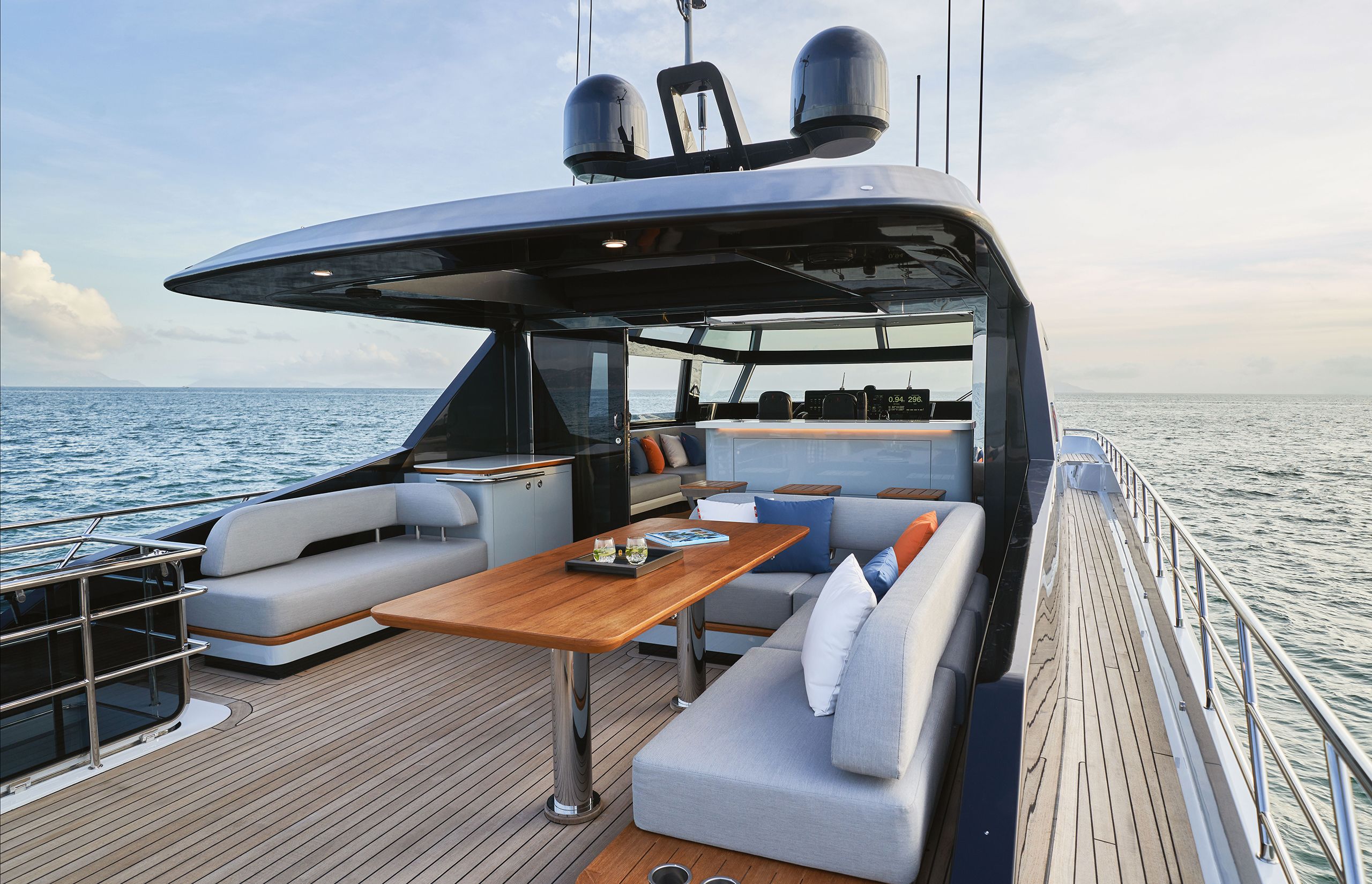
Back on the aft deck, we take the stairs – nice wide steps with a secure handle. Their unusual orientation works well with the boat’s trim. On the upper deck, the crew demonstrates how the deckhouse windows open and close at the touch of a button, as does the built-in canopy over the aft deck. This is the spot for al fresco dining, with a table large enough for eight to 10.
Easily folded director chairs complete the seating. A fridge, range, additional storage and barbecue grill that can handle a Texas-style steak are also found here. CL Yachts knows a dainty grill that will fit a couple of Florida lobster tails won’t do. There is also a bar with custom-made stools and stackable lounge chairs that Forakis designed. “My idea was to make them of authentic boat materials, so that’s marine-grade stainless steel with teak,” he says.

Moving forward, there is a Portuguese bridge overlooking the Piazza del Sole, which can be set up simply with a few lounge chairs. If an owner wants one, there is room here for a spa pool and it can be engineered without changing much of the boat’s trim and performance. “Add it up and we will make it work,” Horsmon says.
To make it work seems to have been the project’s philosophy. They have managed five large independent exterior lounge spaces on a sub-30-metre boat. An amazing feat – and one of the design’s primary goals.
“The idea was not just more space, but diverse types of spaces, so people can gather in small or large groups. This creates an interesting dynamic, so people can socialise or not,” Forakis says.
From here, we get back down to the main deck. Across the low threshold leading inside, oak planks extend visually the teak decking on the outside. But that’s a detail that’s easy to forget as you move inside. The wide-open space and big windows steal the show. The mullions are so thin as to virtually disappear and you get a straight view through the open galley, all the way to the bow.
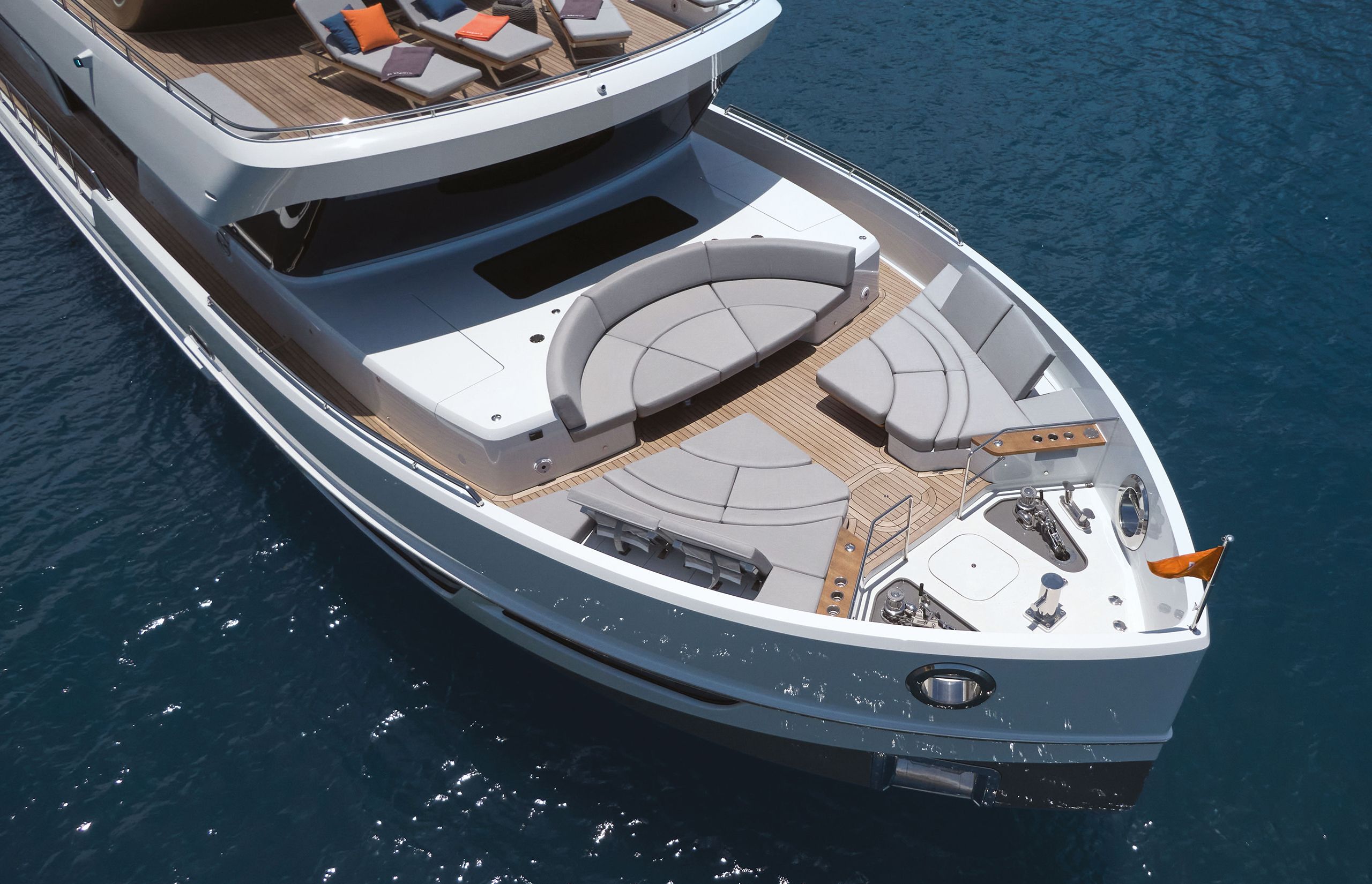
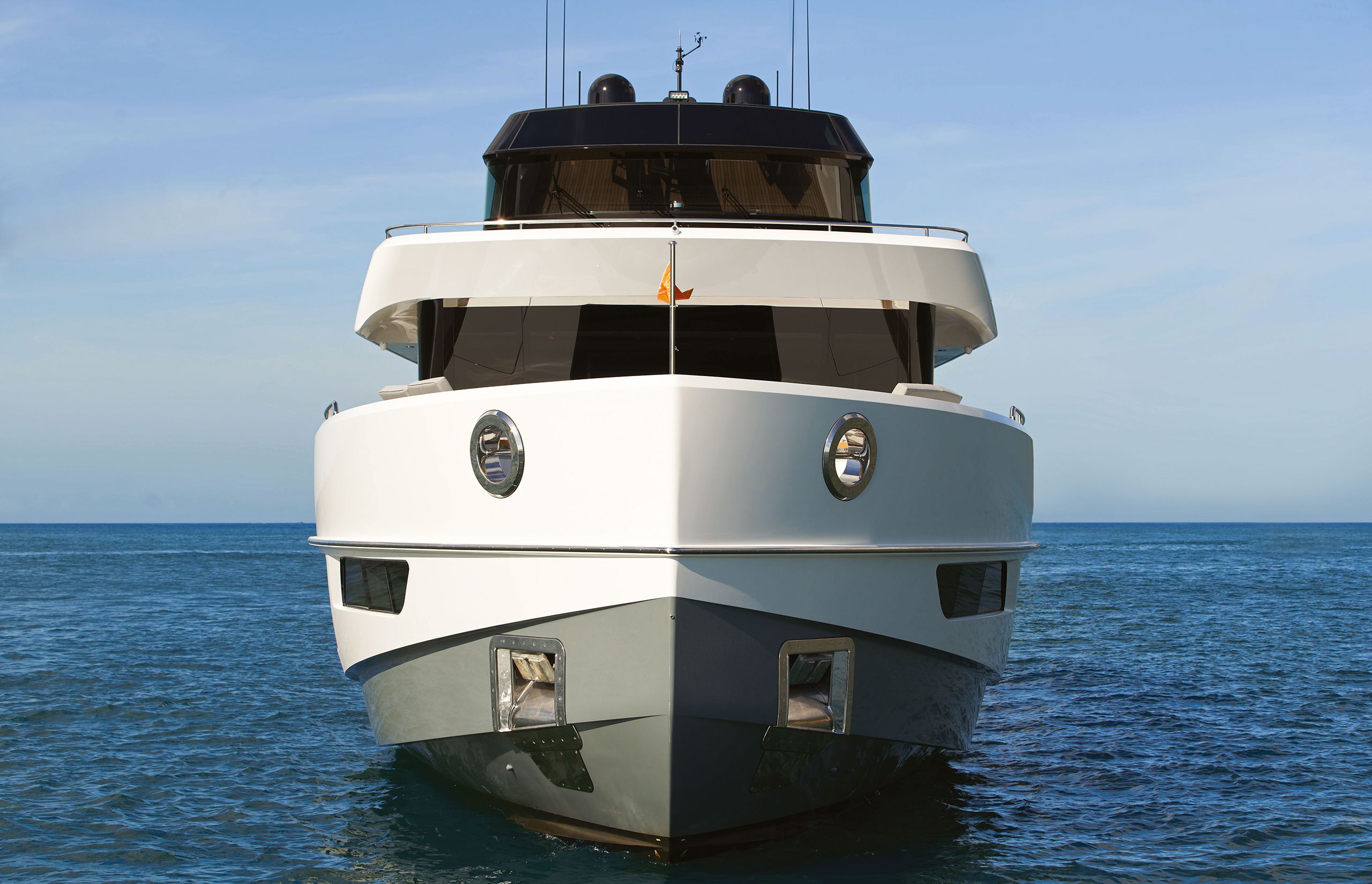
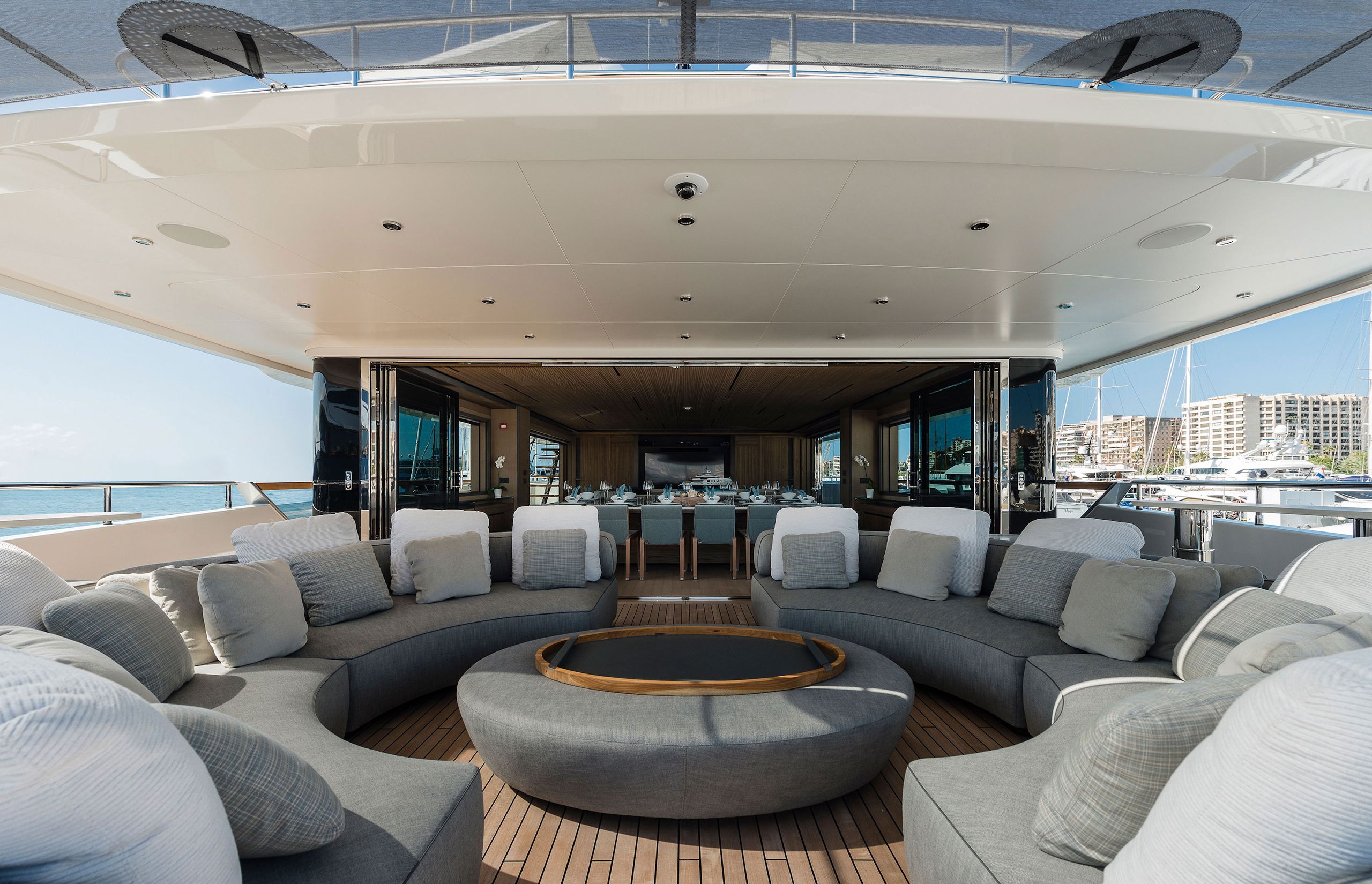

LIGHTSEED STUDIO
LIGHTSEED STUDIO

LIGHTSEED STUDIO
LIGHTSEED STUDIO

LIGHTSEED STUDIO
LIGHTSEED STUDIO
Designer Jozeph Forakis brought a fresh eye to the lounge areas and created a flexible space on the foredeck called the Piazza del Sole, which converts from dining to chill space. Matching the impressive presence above the water, the CLX96’s hull under it incorporates a tapered, rounded keel that transitions to a fine entry at the bow
“In interior design, I have always considered natural light the most important ‘material’ and I try to use it as such,” Forakis says.
Carbon frames, which Horsmon specified for structural support, visually punctuate the large and tall space, and conceal things such as the air-conditioning vents. “I have a deep hate for visible techno details like ventilation grilles,” says Forakis before launching into a deeper discussion about the Coandă effect – how the airflow follows the contours of any shape. “I know that from my days as a designer for LG Electronics,” he says.
The perfectly equipped and elegant galley is open, with only a custom light, which projects a curtain of light to the counter below, separating it visually from the rest of the deck. Forward of that, thanks to the unusual shape of the superstructure, is a comfortable sofa, a small table with a built-in champagne magnum cooler and storage for the flutes, aptly named the champagne lounge. “We made the portside seat extra deep, so you can cuddle or meditate; it’s perfect for yoga meditation,” Forakis says. “The view is fantastic,” he adds. It’s an indisputable fact. There is a dayhead near here as well, convenient to the galley and saloon.
The wide-open space and big windows steal the show. The mullions are so thin as to virtually disappear, and you get a straight view through the open galley, all the way to the bow

We step down to the cabins. The owner’s suite is forward, accessed through a small private lobby behind a door. The wow effect resides in numerous eatures – the full beam, which is a generous 7.5 metres at its widest, a skylight above the bed, low windows that are very close to the water, a large TV screen, which can be hooked up to the forward camera for live views of the sea and horizon, a spacious en suite that has a central shower, with a high-quality porcelain finish and dual toilets hidden behind privacy glass.
The shapes are inviting, soft and harmonious. There is continuity of form on both sides of glass partitions and walls, a testament to what Forakis calls his maniacal nature
The shapes are inviting, soft and harmonious. There is continuity of form on both sides of glass partitions and walls, a testament to what Forakis calls his maniacal nature. And a surprising use of a material that is not that commonly found in spaces like bedrooms: Corian, along with Majilite and glass with strips of wood. “A lot of boats use mirrors, but I think it’s a little kitsch,” Forakis says.
There is a vanity table with a built-in mirror at the right height, worth noting because in most boats, when you sit on the stool, you can’t see your face in the mirror – an oversight noted in even the largest and most sophisticated superyachts.
“The concept caused a little bit of friction within the company. It was just ‘too different, too new, too unlike anything else’”
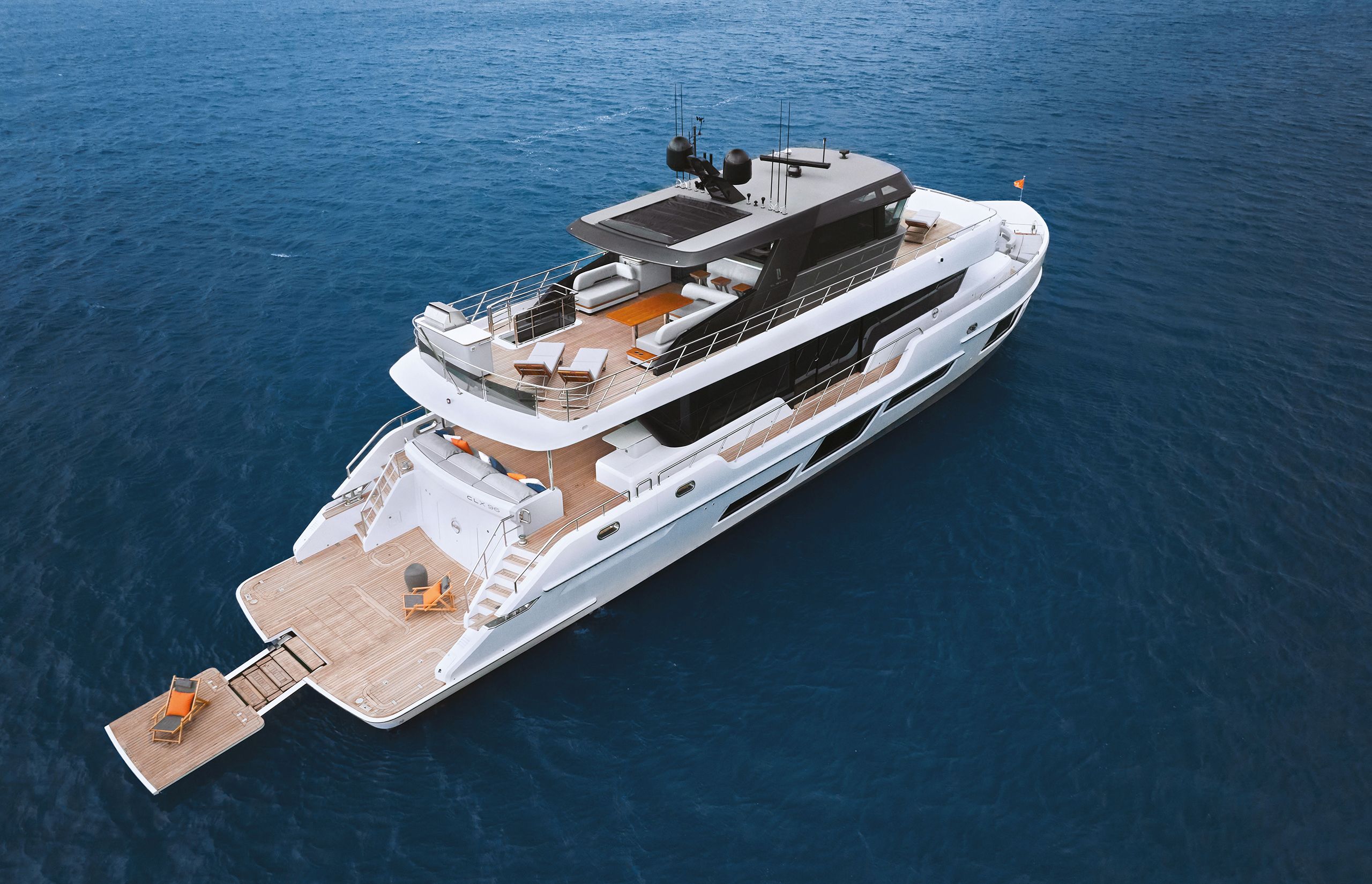
Two twin cabins have similar design features and good space and there is an attractive VIP cabin aft, a slightly downscaled version of the owner’s cabin. Here, pocket doors close off the bathroom that faces the portside portholes. To recall the skylight in the owner’s cabin, over the bed is a virtual skylight, which connects to a camera on the mast to show live images of the sky.
Soon after the captain pulls off the dock, we migrate to the upper saloon and, from here, we can see the sky and sea from every angle. While the captain cruises at close to 20 knots, it’s quiet up here, except for the radio chatter.
For all its novelty, including a designer who comes from outside of the world of boat design – Forakis is an awarded and prolific industrial designer – this boat is the product of experience. Alfaro, for instance, is a Florida-based naval architect who started his career 35 years ago working with Tom Fexas. He says CL Yachts’ venture with Forakis is not unlike that experience of a few decades ago. In 1980, CL Yachts’ parent company, the prolific commercial and yacht builder Cheoy Lee, banked on the rising star that Fexas was at the time.
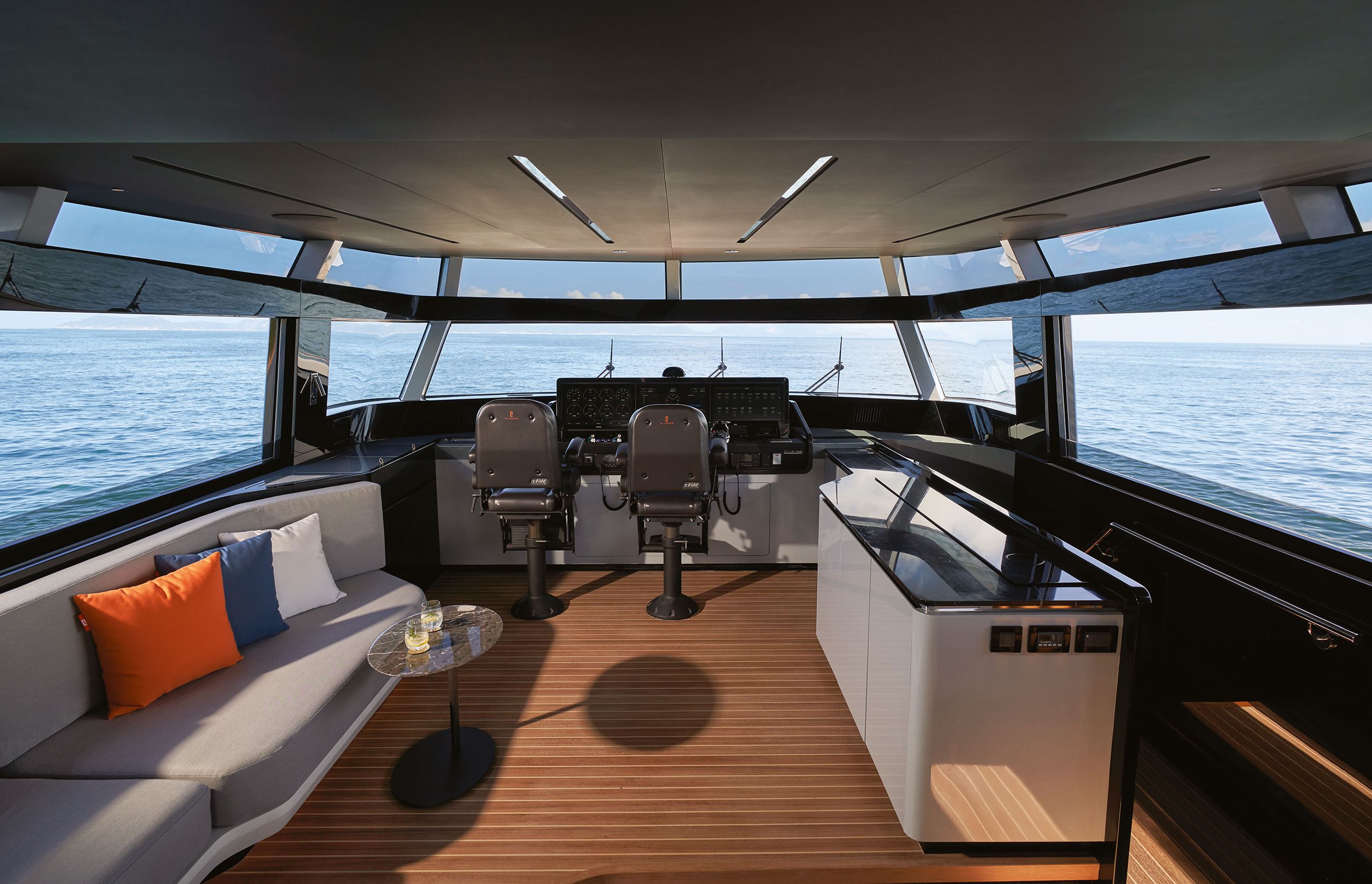
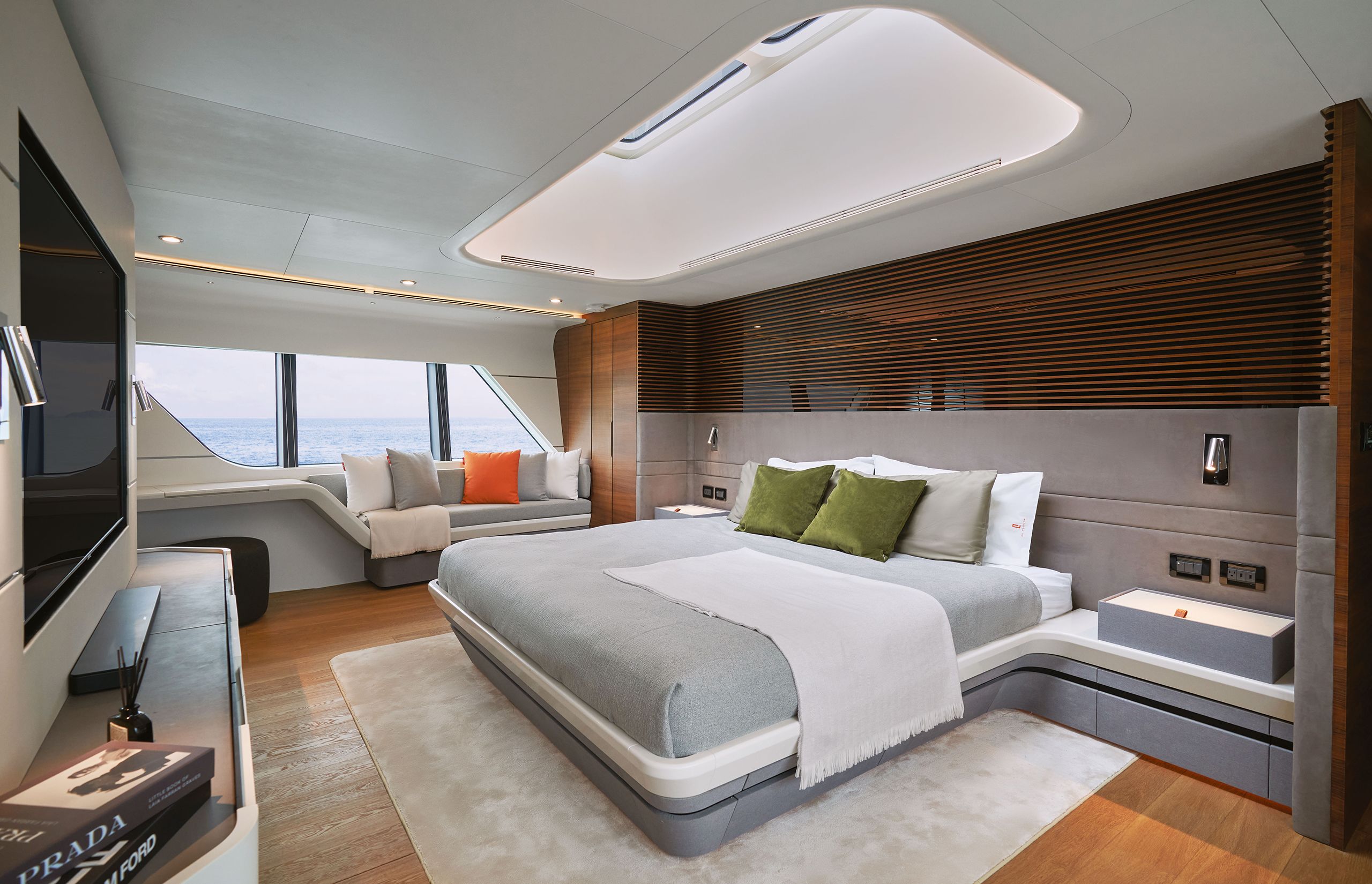
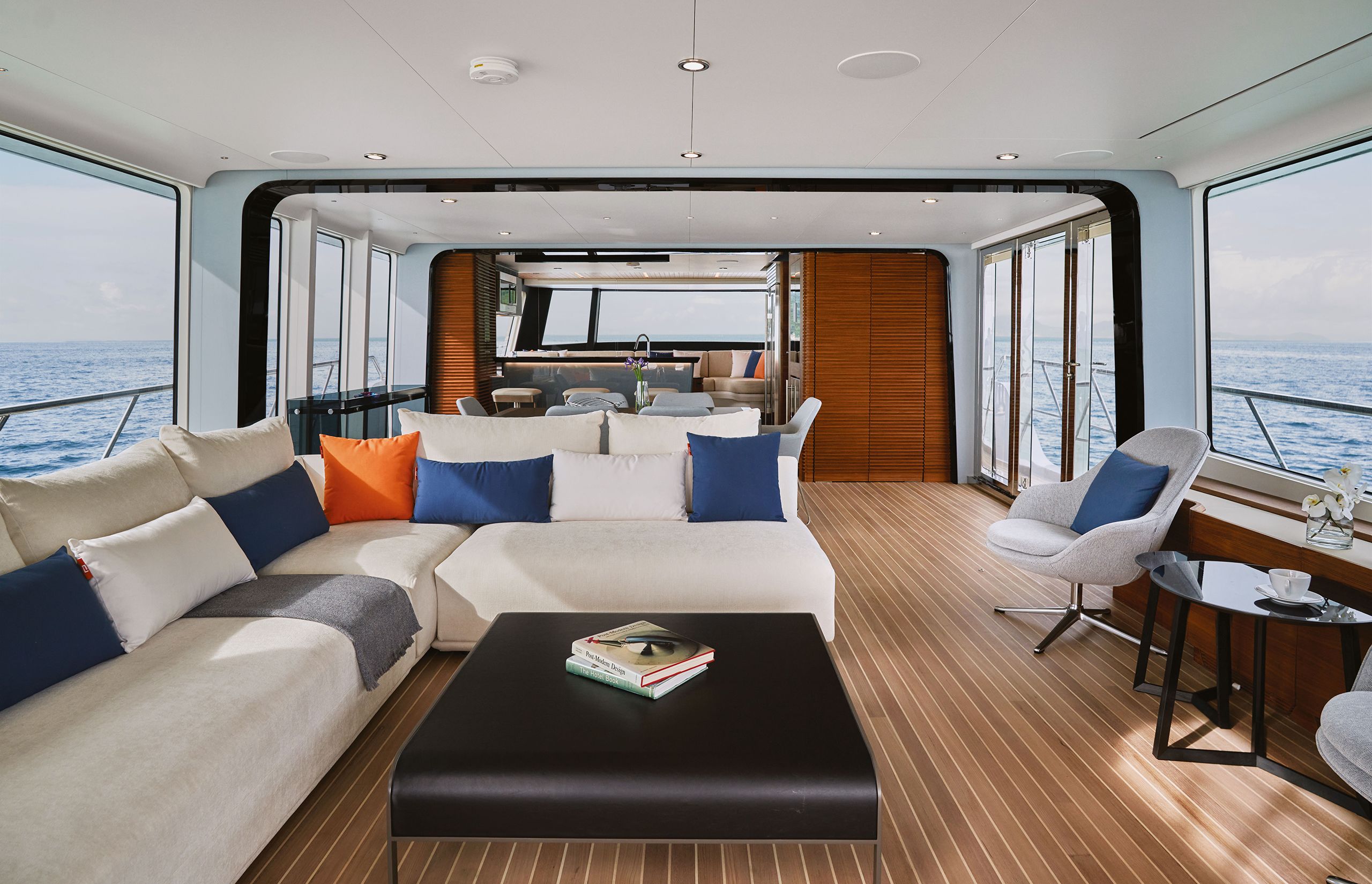
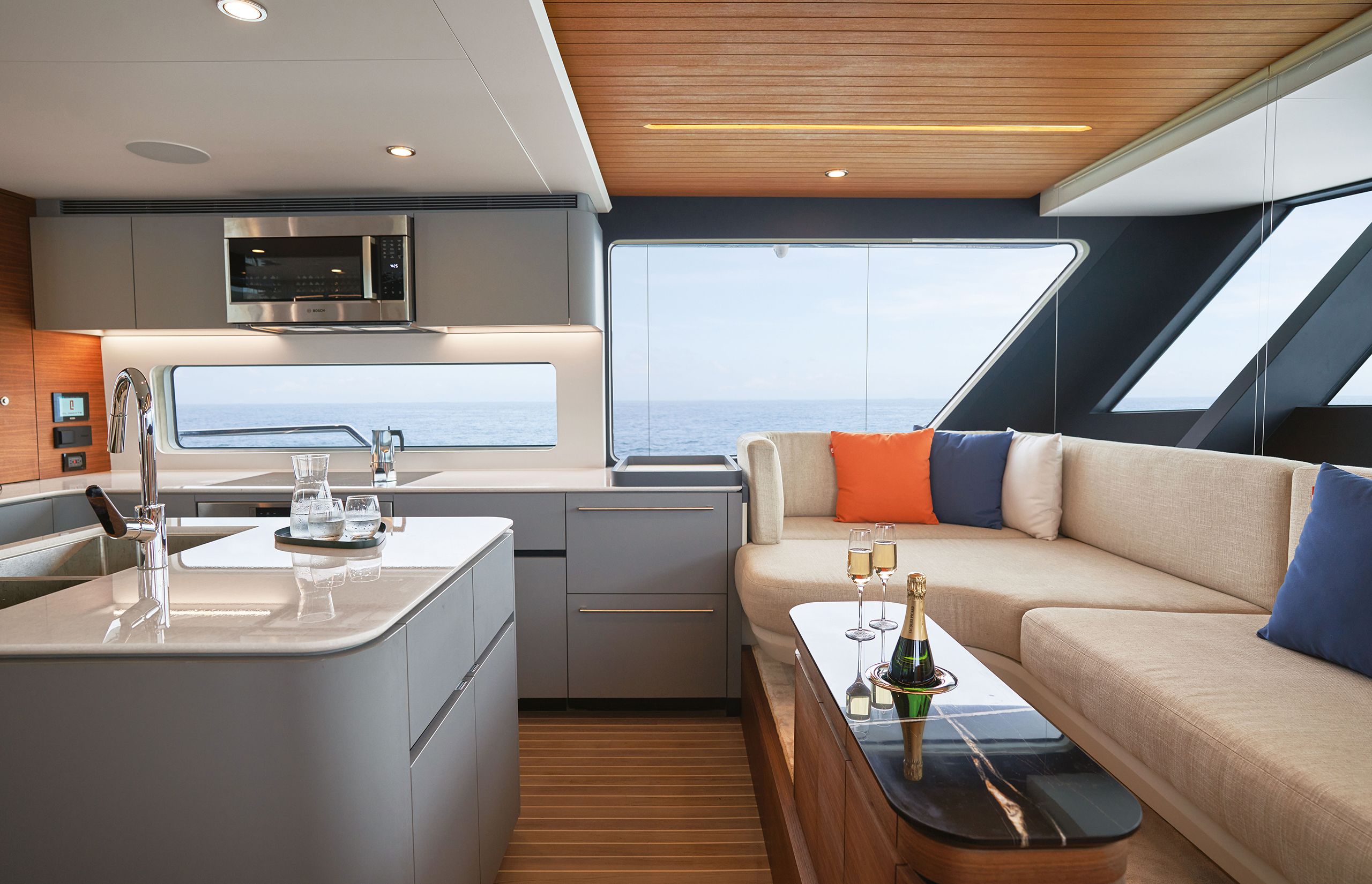
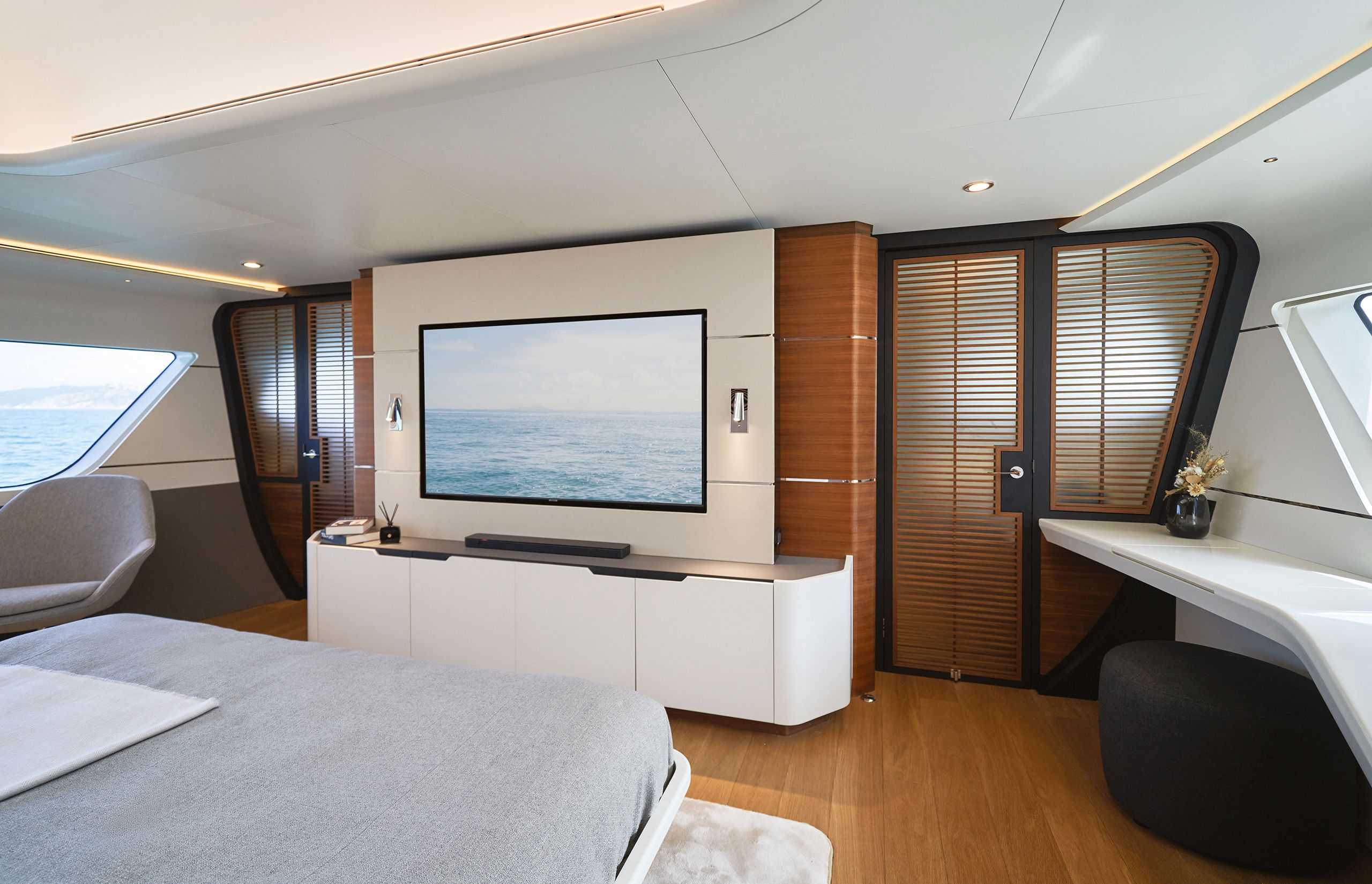

LIGHTSEED STUDIO
LIGHTSEED STUDIO

LIGHTSEED STUDIO
LIGHTSEED STUDIO

LIGHTSEED STUDIO
LIGHTSEED STUDIO

LIGHTSEED STUDIO
LIGHTSEED STUDIO

LIGHTSEED STUDIO
LIGHTSEED STUDIO
Adding to the modern feel, the main saloon’s sofa and coffee table are from Camerich, and Fenix created the dining table’s custom top and the galley’s worktop. The fabrics covering the cushions and custom sofa are from Sunbrella. Top right: The king-size bed in the full-beam owner’s suite. Bottom right: the 65-inch TV acts as a virtual porthole, with a live feed from an HD camera situated at the bow
When CL Yachts was born as a new brand of the historic shipyard in 2017, it needed someone like Fexas who could disrupt the status quo and fire up the imagination of a younger, hipper clientele. Enter Forakis. It was his livery design for the Leonardo AW609 next-generation VTOL aircraft that caught the attention of Martin Lo, director of CL Yachts, initially.
Forakis, like Fexas, was born and raised in New York, although he now lives and works in Milan. “I think very consciously, they were looking for this spirit of innovation to reset the future direction of what is a known brand,” he says.
Soon, he was on board with CL Yachts, working on the new brand: logos, brochures, the works. At the 2019 formal unveiling of CL Yachts in Miami, the company showed two boats that introduced some innovation and new materials but did not stray too far from the norm. Then came the Forakis-designed CLB88, a more adventurous but still a classic boat in many ways – especially compared to what was to come next.
After extensive research, Forakis developed six or seven designs, some even more out there than what became the CLX96, which won in an internal contest.
Large, low windows and a skylight above the bed fill the full-beam owner’s suite with natural light
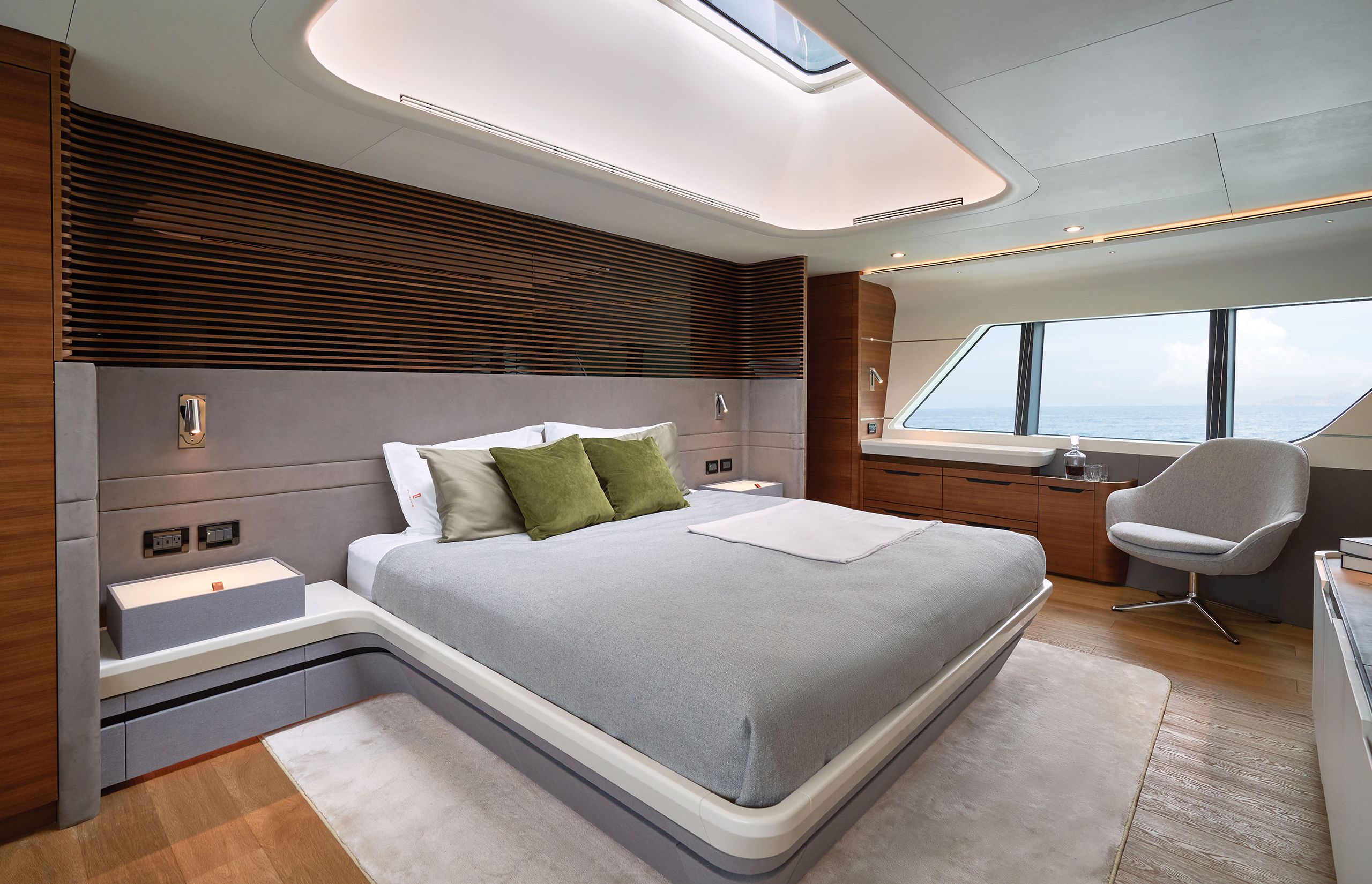
“Martin [Lo] got this concept right away and it caused a little bit of friction inside the company. There were people who really liked it and people who were really against it. And we had to campaign within the company,” Forakis says. It was “just too different, too new, too unlike anything else; [we heard] the market is not ready for it. We were spending four to six hours a day on the phone for the first two years, long conference calls between the US, Milan and Hong Kong. I remember one call early on when I tried to convince people. I said, ‘My team and I are in the future; this is what the future looks like. You must have a bit of faith’.”
One of the early detractors was Hans Lo, the brand’s deputy director, who represents the younger, hipper clientele CL Yachts aims to capture. “[Now,] I think it’s fantastic. You get the best of both worlds, generous volume and different zones, but you are getting all that without compromising on performance. It has everything,” he says.
The comfortable, open feel of the upper deck comes from the shape of the superstructure. It is an unexpected design feature. Inclined in opposite directions, front and back, it recalls the inclined trapezoidal shapes of windows in the hull, which itself ends with a vertical bow.
“One of the first striking things about the design, when you see her from a distance, is the double reverse shape of the house,” Forakis says. “Beyond the connection with outdoors and nature, the feeling I wanted to evoke was the sense that you are on a vessel transporting you into the future with supreme comfort and understated style,” he says. “I tried to put as much functionality [into it], so it’s clear it’s not just a whimsical design.”
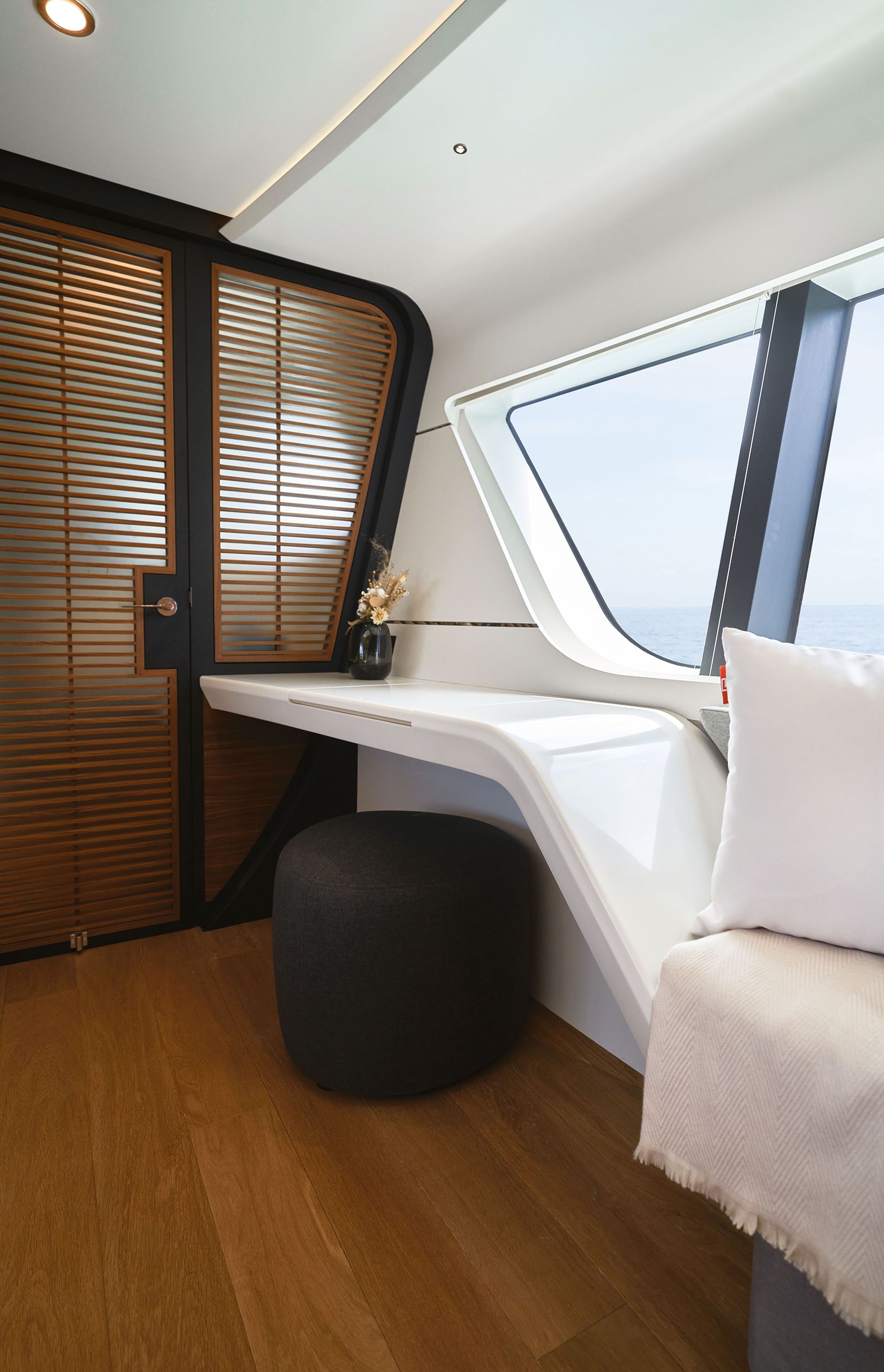
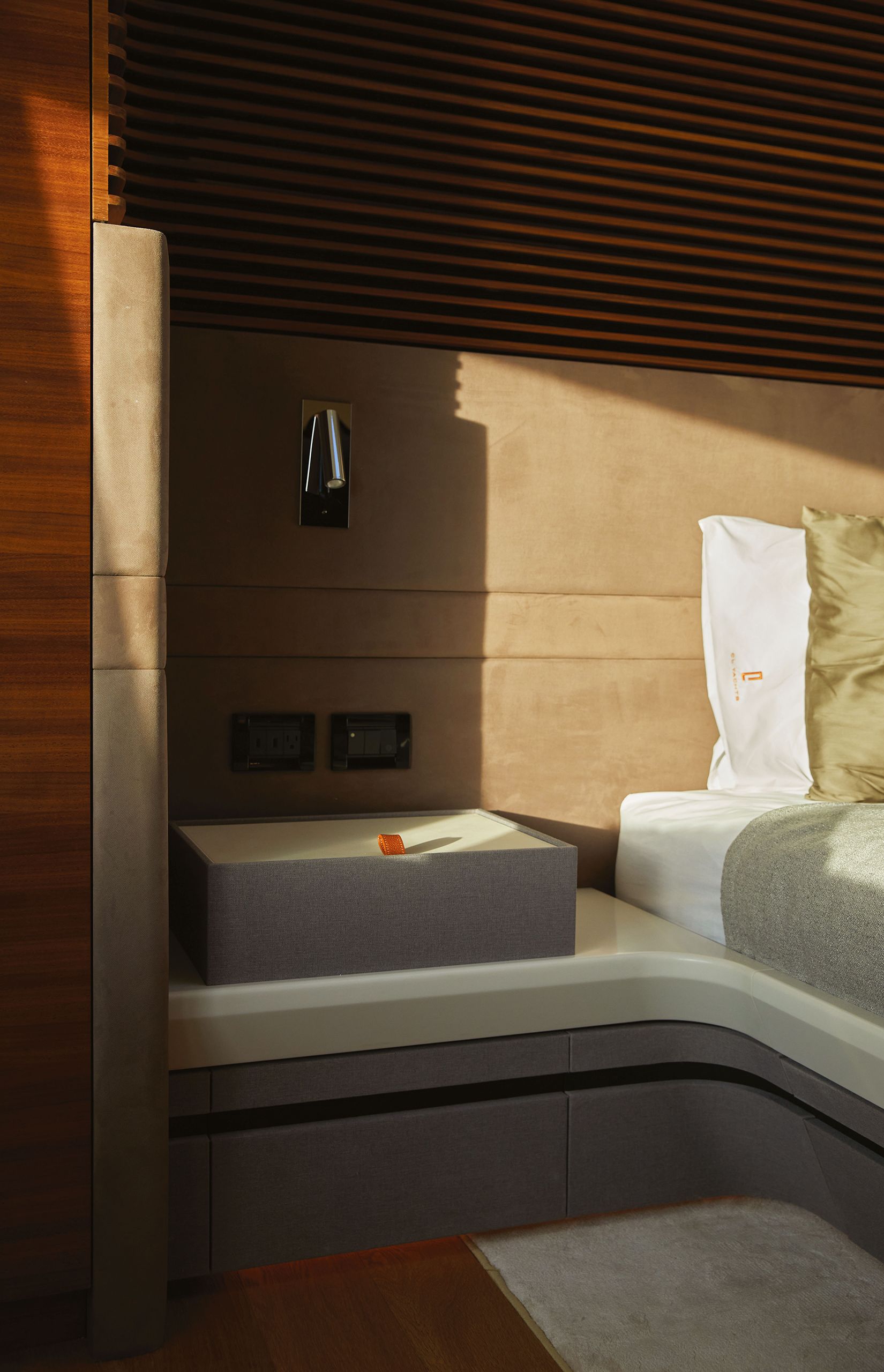
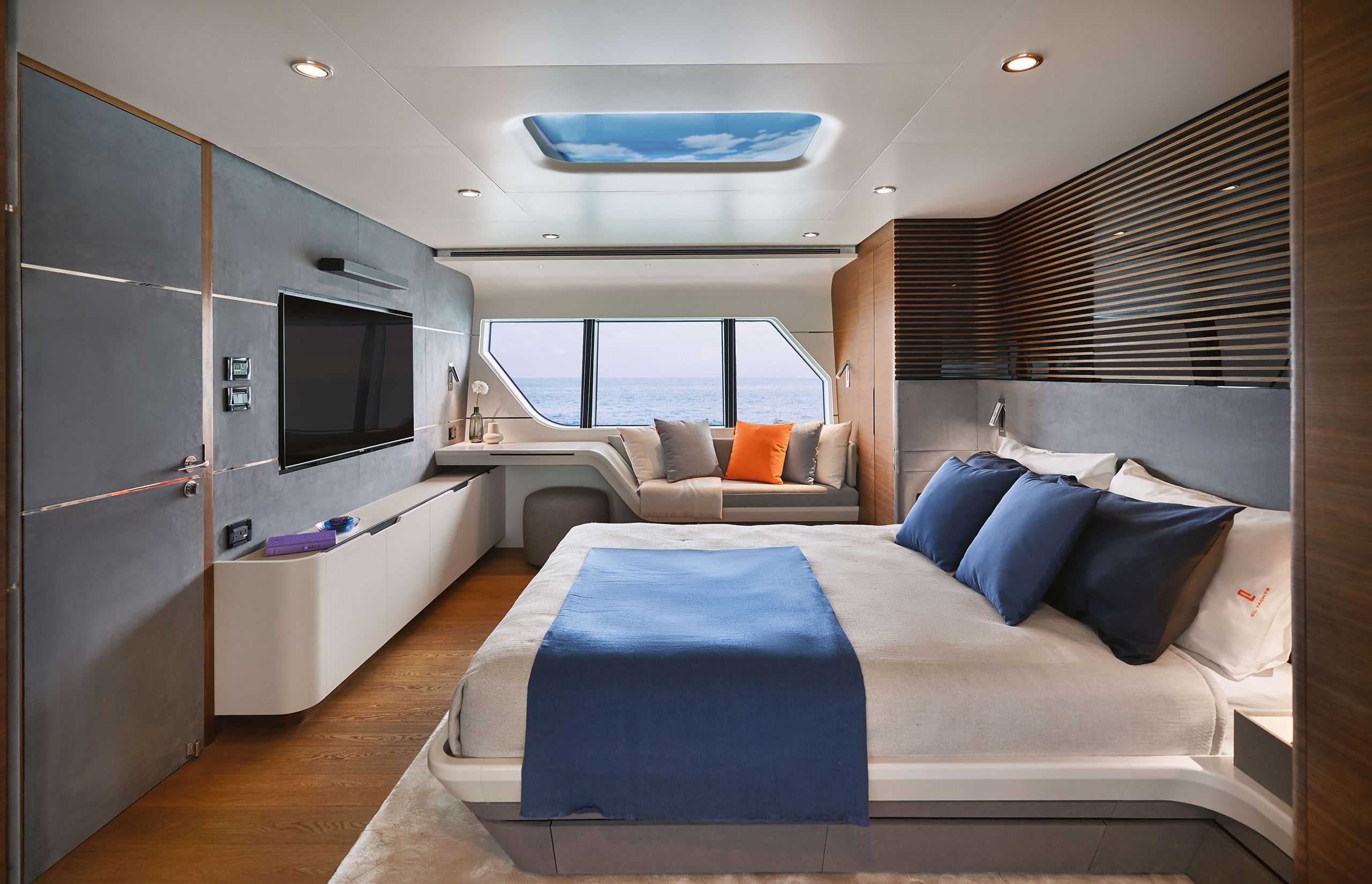
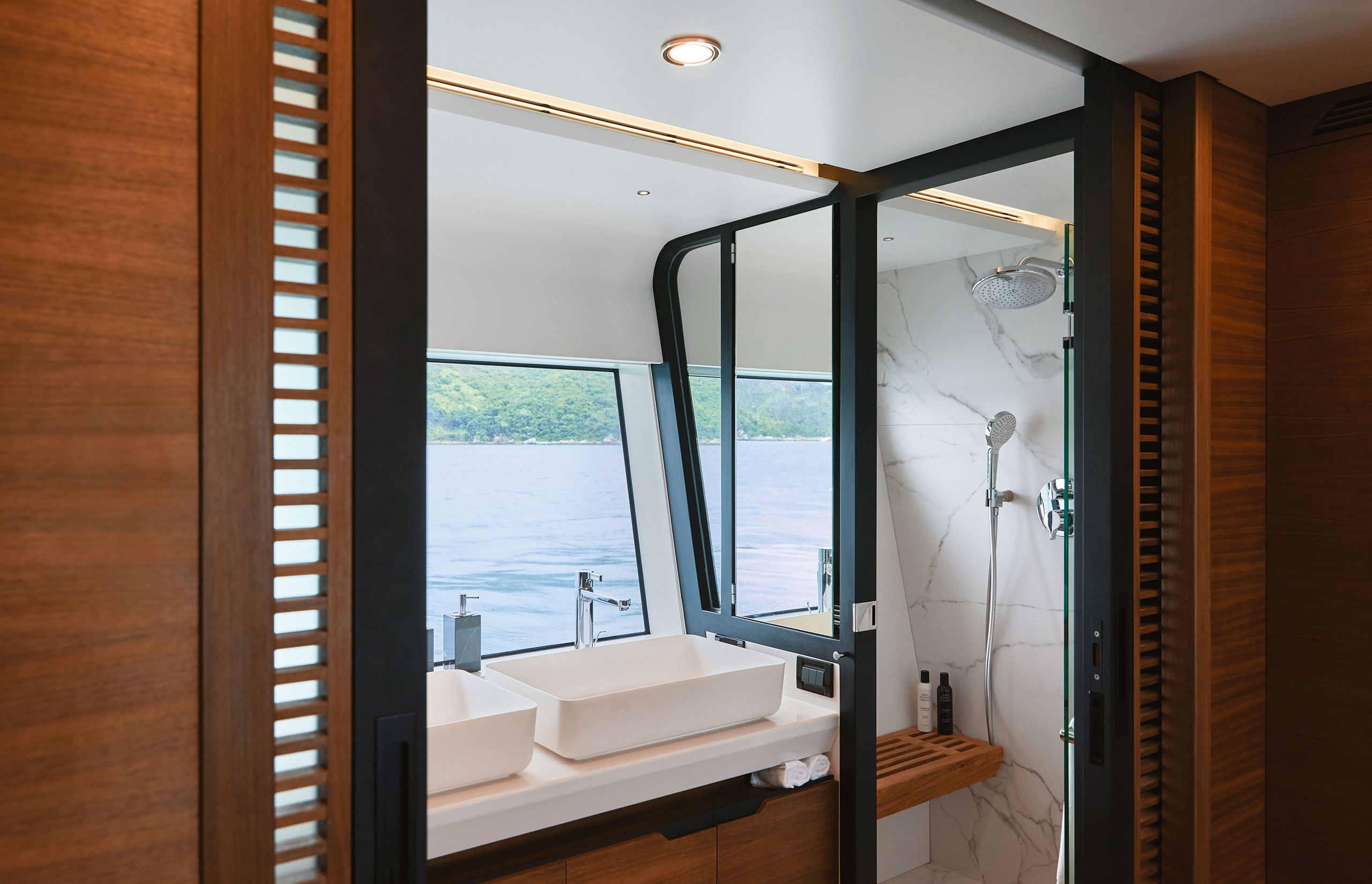
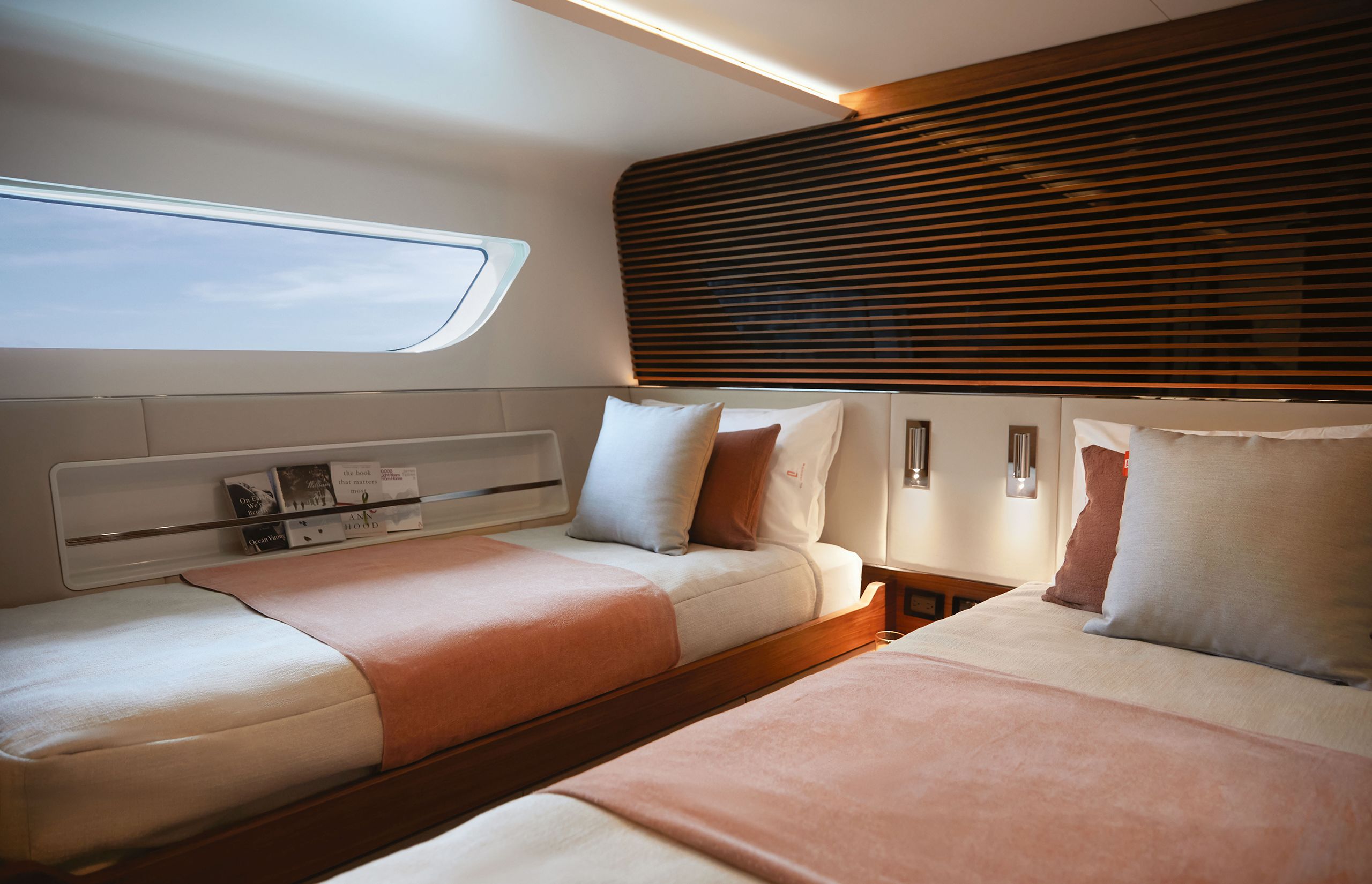

LIGHTSEED STUDIO
LIGHTSEED STUDIO

LIGHTSEED STUDIO
LIGHTSEED STUDIO

LIGHTSEED STUDIO
LIGHTSEED STUDIO

LIGHTSEED STUDIO
LIGHTSEED STUDIO

LIGHTSEED STUDIO
LIGHTSEED STUDIO
Top: Corian is used so widely throughout the cabins that the shipyard had to train its technicians to carve and machine it. The themes of openness and connectedness continue throughout the yacht, including in the smaller guest cabins (bottom right) and the VIP en suite (bottom left)
It creates interesting spaces, opens the interior and tells the story of the shipyard. “I always try to be inspired by the authenticity and the history of the company [I design for] and the fact that they are one of the big players both in commercial and luxury yachts, that idea of that sort of crossover was born from that,” the designer says.
If it gives this yacht its unique appearance, it also made this project a difficult puzzle to resolve. The shipyard working with Horsmon studied various solutions to carry out the designer’s vision. They thought of building the structure in metal but eventually went for a carbon primary structure with remarkably thin mullions that are load-bearing, a true engineering feat.
The main reason for the choice of carbon, Horsmon says, is that “it gives you very good stiffness for little weight. You see the huge glass surfaces, you must support them with something. If you just did it with E-glass [normal fibreglass], it would not be stiff enough. It would be shaking all over the place.” It doesn’t.
“The hull itself, developed using CFD, is the result of a complex recipe and incorporates elements you’d find on what European naval architects refer to as fast-displacement hulls but with hydrodynamic properties that allow the vessel to plane,” according to the naval architect.
The premise was complex, but they were always aiming for speed. The yard thought of using Volvo Penta IPS (as it does on some of its smaller models, including its CLB65) but at the time, the pod size and propeller combination wasn’t available for this application, so the CLX96 is powered with 1,900hp Caterpillar C32 ACERT engines.
“The feeling I wanted to evoke was the sense that you are on a vessel transporting you into the future with supreme comfort”
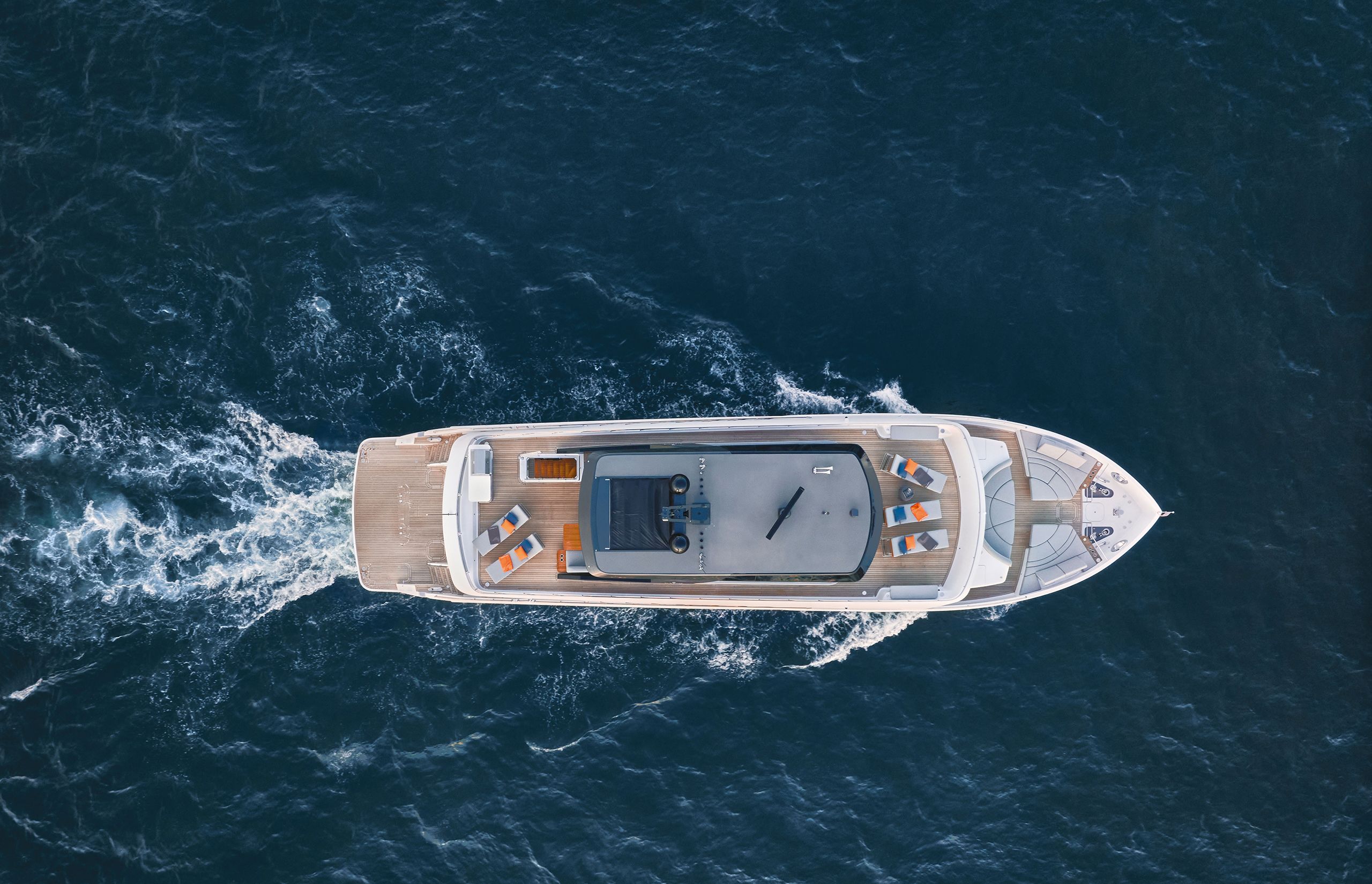
“We still have features that we incorporate into an IPS boat, including reverse main chines and moderate deadrise in the stern, but we also incorporated a tapered, rounded keel that transitions to a fine entry at the bow,” Alfaro says. Whatever the recipe, it worked.
On our cruise, an easterly wind fought against the yacht and we reached 25 knots at full throttle, burning 760 litres per hour at that speed. “I had this boat running about 27 knots,” the captain says. On this day, the boat cruises very comfortably at 19.5 knots and 2,000rpm, with fuel consumption of about 455 litres per hour total, and the fuel burn drops quickly with the speed.
The helm itself is a neat package with carbon details and crisp, colourful displays a metre or so wide that are easy to read and are easy on the eye.
From top to bottom, this is an interesting yacht that’s easy to get comfy in. Yes, it could be seen as a bit of a gamble on the part of CL Yachts to build the unusual CLX96 on spec, but it’s a calculated risk. Volume, light and smart design sell.
First published in the February 2023 issue of BOAT International. Get this magazine sent straight to your door, or subscribe and never miss an issue.
The Portuguese bridge is extra large
The “champagne lounge” offers views out while seated
Tri-fold glass doors open up the dining room to the outdoors while seated
Teak planks give way to oak to visually connect the indoors and out
Crew quarters for four buffer the VIP from the engine room.
A crane is hidden under the deck

